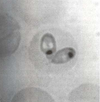Image ID - Exam II Material Flashcards
(74 cards)
Identify the parasite. What life cycle stage is infective?

Parascaris equorum - L2 in egg is infective
Identify the parasite. Is this oocyst sporulated or unsporulated?

Eimeria leukarti - sporulated
Identify the parasite.

Ixodes spp
Identify the parasite. What life cycle stage is present?

Tabanus spp adult
Identify the parasite. What life cycle stage is present?

Fasciola hepatica egg
Identify the parasite.

Setaria equina
Identify the parasite. What parasite does this fly transmit?

Stomoxys calcitrans.
Transmits Habronema
Damn, what’s that on his hand?!?!

Culicoides spp. - “No-see-ums”
Identify the parasite. What life cycle stage is present? Common name?

Strongyloides westeri adult - threadworm
Identify the parasite. What life cycle stage is present? How would you diagnose this parasite?

Sarcoptes scabiei adult
Skin scraping
Identify the parasite. What is this parasite responsible for transmitting?

Rhipicephalus sanguineus - Transmits Babesia & Ehrlichia
Wow, what a prominent, rigid, conspicuous, and forward projecting proboscis! This must be from:

Stomoxys calcitrans
Identify the parasite.

Musca domestica
What is the common name of this parasite?

Assassin bug
Identify the parasite. Are these eggs laid embryonated or unembryonated?

Strongyloides westeri egg. Embryonated
What is the common name for this parasite?

Sarcoptic mange mite
Identify the parasite.

Trichodectes canis
What are the primary hosts for the parasite pictured?

Cuterebra spp. - Rabbits and rodents are primarily hosts
Identify the parasite. What life cycle stage is present?

Linognathus vituli adult
Identify the parasitic egg

Draschia megastoma egg
Identify the parasite. What life cycle stage is present?

Oxyuris equi eggs
Identify this parasitic egg

Habronema spp.
What is the common name for the parasite pictured?

Coccidia
Identify the parasite. What is/are the site(s) of infection?

Demodex canis - hair follicles and sebaceous glands



















































